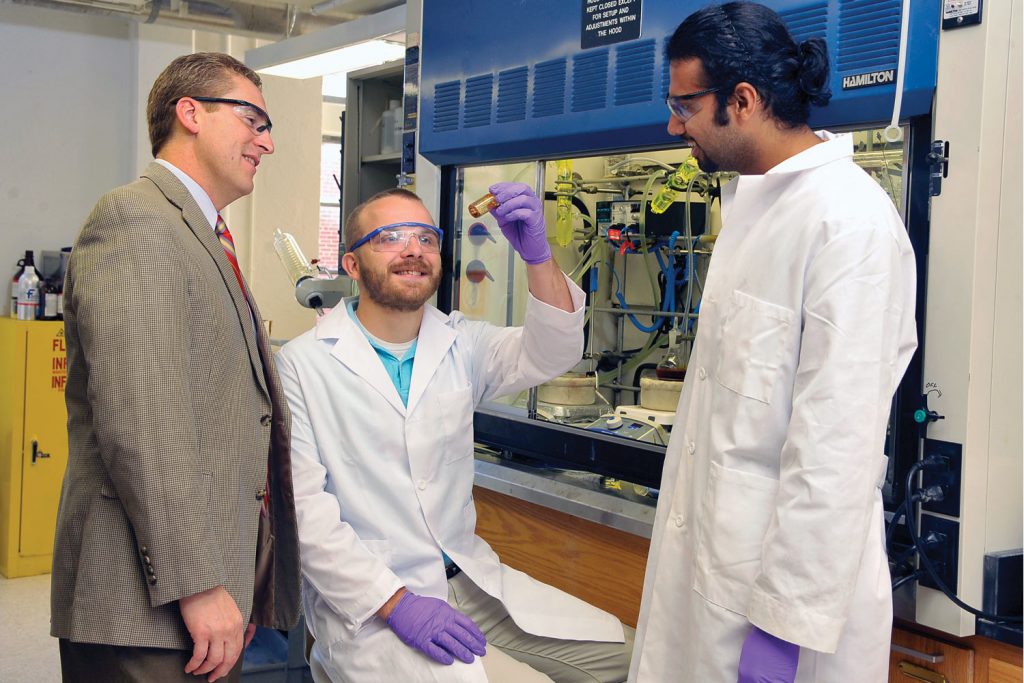When Michael Kilbey came to Oak Ridge National Laboratory (ORNL) on a sabbatical a few years ago, the visit resulted in an appointment as a professor in the Department of Chemical and Biomolecular Engineering.
“I came to East Tennessee on a sabbatical to ORNL to learn neutron scattering methods applied to polymeric materials,” Kilbey said. “Prior to that, I had been a member of the Department of Chemical and Biological Engineering at Clemson University for 11 years. At the end of that sabbatical year I had the opportunity to stay—to become a UT/ORNL joint faculty member. I felt that the growing research intensity at UT and the new facilities at ORNL were a compelling opportunity, so I made that change. Initially, my joint appointment was between the UT Department of Chemistry and ORNL. In 2012, I began the process to return to academia full time, and was pleased that the CBE department was interested in having me join their faculty. I began full time at UT in the fall of 2013, with a joint appointment between the Department of Chemistry and CBE.”
Kilbey was born in Wisconsin and grew up in La Crosse. His father was an engineer, and he enjoyed chemistry and math in high school. The combination of those factors influenced him to study chemical engineering.
He received his BS degree at the University of Wisconsin-Madison and his PhD at the University of Minnesota.
Kilbey’s current research interests focus on understanding the relationships between the chemical design of polymeric materials and their structure and properties in thin films and in solution. His research group is engaged with the Tennessee Solar Conversion and Storage using Outreach, Research, and Education (TN-SCORE) program, the state’s first National Science Foundation (NSF) RII Track 1 Research Infrastructure award. Kilbey’s team is also involved in the Sustainable Energy and Education Research Center (SEERC), a research initiative designed to thrust the UT Knoxville campus into the technological forefront as a global nexus of sustainable energy research, education, and innovation through partnerships with local, national, and global organizations with common interests, such as ORNL and the US Department of Energy (DOE), as well as concerned private corporations and foundations. The team also is coordinating research projects with the Institute for Biomedical Engineering (iBME), a program that incorporates engineering and medicine and unites three diverse campuses in a multi-disciplinary collaboration.
In addition to his work in the lab, Kilbey also enjoys his teaching responsibilities.
…the enterprise of trying to empower students to better themselves through education and to help them become lifelong learners is a serious and enjoyable endeavor to me.”
“Interacting with students guarantees that every class is different, and every day there is an opportunity to open a door for students to walk through,” he said. “It doesn’t always work out that way, but the enterprise of trying to empower students to better themselves through education and to help them become lifelong learners is a serious and enjoyable endeavor to me.”
Kilbey is enjoying his time in CBE, and has long-term goals for the future.
“I want to continue to provide opportunities to students, both through classroom teaching and learning through research. I think learning through research may be the most stretching experience many of our students undertake–answers are not known, outcomes are not given, and success requires persistence and developing a depth of knowledge that changes and increases daily,” he said. “ I would like to see UT’s research stature and scope of research increase–particularly in soft materials, which are increasingly called upon to solve challenges in energy, the environment and human health, to name a few. Partly in response to that goal, along with my colleague Mark Dadmun in the Department of Chemistry, and backed by UT, we have developed the Soft Materials Research in Tennessee (SMaRT) Center, which we hope will serve as a focal point and generate new opportunities that engage a variety of researchers from various disciplines.”
